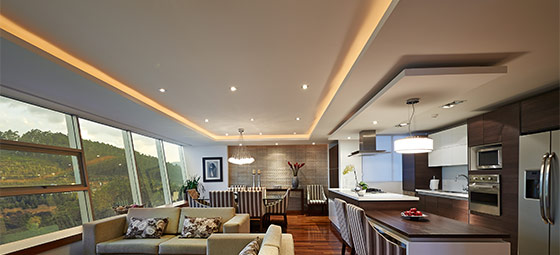You’ve remodeled your kitchen, making it worthy of a gourmet chef, but without the right lighting, much of your efforts may go unnoticed. Inadequate lighting in the kitchen is a common mistake many people make. But how a kitchen is lit affects the functionality of the room. In addition, proper lighting can help avoid eye strain and save on energy bills.
The best lighting approach for the kitchen, or any room for that matter, is a layered lighting approach that combines four different types of lighting to create a dramatic and effective lighting scheme.
Ambient lighting is the general overhead lighting. Ambient lighting should be the foundation of your lighting setup. It should be a soft light, not too bright, that conveys warmth and sets a mood. Ceiling fixtures, chandeliers, torchieres, and pendant lighting are all good options for ambient lighting.
Accent lighting is used to highlight a specific feature or object, such as artwork, architectural features, or centerpieces. Accent lighting should be brighter than ambient lighting. Track lighting, recessed directional lighting, uplights, and wall scones are all good choices.
Task lighting is used to illuminate work spaces for completing tasks, such as cooking, chopping, or reading recipes. Task lighting should be the brightest lighting in your lighting setup. Under-cabinet lighting and pendant lighting are great task lighting fixtures.
Decorative lighting is used to enhance the design of your kitchen and add interest. Think of decorative lighting as bling for your kitchen. The scale of the fixtures you select should be appropriate for the size of the kitchen. A larger kitchen will need a larger fixture, while a smaller kitchen would be overwhelmed by a large fixture. Decorative lighting is typically the most expensive lighting style. Chandeliers, pendant lighting, and scones make excellent decorative lighting.
When all four layers are blended together, the result is a warm and inviting environment. All four of these lighting styles can be incorporated into any sized kitchen. Some fixtures can serve multiple purposes. For example, pendant lighting can be both decorative and ambient. But no light fixture can provide all lighting styles. When you fall into the trap of only using one or two lighting styles, your kitchen won’t look or function as great as it could. Using only ambient lighting will result in a room with no depth, dimension, or visual interest and makes it difficult to perform tasks. Using only accent lighting focuses attention on objects but leaves people in the shadows. Decorative lighting by itself is distracting to the eye.
To get the greatest flexibility from your new layered kitchen lighting, consider putting each layer of lighting on its own zone with its own dimmer or switch. Separate dimmers and switches will allow you change and customize the lighting levels for different scenarios and purposes.

